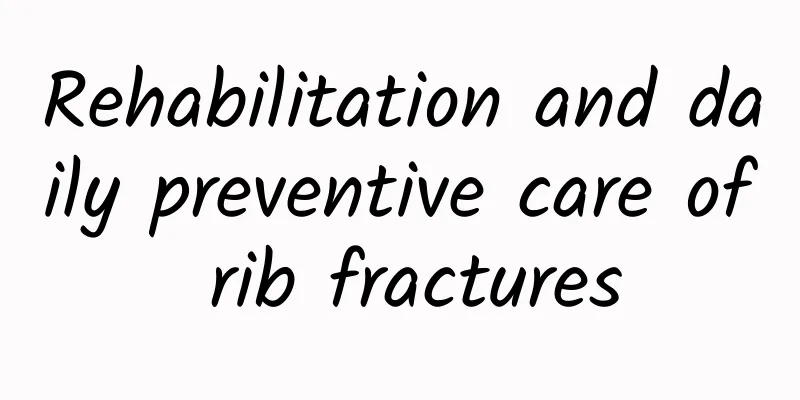Rehabilitation and daily preventive care of rib fractures

|
This is the 3627th article of Da Yi Xiao Hu Rib fracture is the most common chest injury, which is caused by direct force acting on the ribs, causing the ribs to bend inward and break at the stressed part, or by front and back compression, causing the rib body to bend outward and break. Severe rib fractures can cause respiratory failure and shock. Rib fractures often present as pain, with local pain at the ends of the rib fractures, which is aggravated by deep breathing, coughing, or turning the body. There is obvious tenderness at the fracture site, which is aggravated by indirect compression of the fracture site. When the pleura or lung is pierced, it may be accompanied by chest pain. Abnormal breathing: two or more fractures occur in two or more adjacent ribs, causing the local chest wall to lose complete rib support and soften. During spontaneous breathing, the softened chest wall collapses when inhaling and protrudes relatively when exhaling. In severe cases, respiratory failure and shock may occur. The fracture ends pierce the pleura, intercostal blood vessels, and lung tissue, which may cause hemothorax, pneumothorax, subcutaneous emphysema, or hemoptysis. When the ribs are fractured, pulmonary contusion combined with hydropneumothorax, heart injury, clavicle fracture, scapula fracture, and pleural hypertrophy in tuberculous pleurisy often occur, which can easily lead to misdiagnosis. During the healing process of rib fractures, expanded calluses are formed at both ends of the fracture, which are similar to nodular pulmonary lesions. Especially in the elderly, it is easy to misdiagnose as nodular pulmonary lesions in the absence of an obvious history of trauma. Especially when the rib fracture is transverse, in cases where it is difficult to make a diagnosis, a CT scan should be performed. CT scans have high resolution and the trabeculae are clearly visible through the fracture seams. So how do you prevent rib fractures? 1. Pay attention to sports and travel safety Rib fractures are common in sports injuries, traffic accidents, and daily work. Sports injuries are common in intense sports such as basketball, football, and rugby. In strenuous exercise, it is especially important to pay attention to sports protection to prevent rib injuries during exercise. In addition, complying with traffic regulations and working legally and safely are also important factors in avoiding rib fractures. In addition, falls in the home among the elderly, especially in bathrooms and kitchens, are also very common. Providing a safe home environment is very important to reduce the occurrence of fractures. Prevention of this type of fracture is relatively common. 2. Encourage more activities Moderate exercise can strengthen bones, maintain muscle strength and a good sense of balance, and reduce the chance of falling. This is also one of the ways to prevent fractures. 3. Develop good living habits People with bad living habits such as long-term smoking, excessive drinking, sitting more and less exercise, and low-calcium diet are prone to osteoporosis in old age. So don't smoke, drink less, don't drink strong tea, and don't eat too much high-protein food. 4. Preventing falls in elderly patients The elderly suffer from osteoporosis and their ribs are very fragile, so they should try to use walkers, crutches and other aids, install more handrails or anti-slip devices in the city, avoid dangerous behaviors such as riding electric bicycles, and prevent falls and accidents. Rehabilitation of rib fractures 1. Fracture fixation: Rib fractures are located in special positions. When there is obvious dislocation of rib fractures, surgical reduction and internal fixation with steel plates are required to restore the function of the broken ends or heal the anatomical position as soon as possible. If there is no obvious dislocation, a chest strap can be used for fixation. 2. Avoid strenuous activities, avoid chest expansion exercises, avoid lifting heavy objects, and avoid high-intensity exercise. 3. Actively cough and expectorate. Patients with rib fractures, especially the elderly, should take deep breaths regularly and actively cough and expectorate to prevent lung infections, atelectasis, etc. 4. Eat a reasonable diet. In the early stage of rib fracture, you should eat light food. Two weeks after the fracture, you can eat high-energy, high-protein food to promote recovery of vitality. Eat more foods rich in vitamin C to promote the body's absorption of calcium. I hope that all patients with rib fractures can benefit from reading this and recover soon. Author: Shanghai Seventh People's Hospital Ju Yufeng Tian Tianning Some pictures are taken from the Internet. If there is any infringement, please let us know and they will be deleted. All names and place names are pseudonyms and any similarity is purely coincidental. |
Recommend
How long does it take for the lochia to be clear after miscarriage?
Many pregnant women are very concerned about one ...
What are the dangers of high estrogen levels?
For women, if the estrogen secreted by the body i...
How many times should you do ultrasound during pregnancy and what should you pay attention to?
The question of how many times should we do B-ult...
What are the symptoms of kidney failure in women?
In our daily life, many women have poor stress re...
What should I do if I get angry after eating pomegranate? Can I eat pomegranate seeds with patterns on them?
Pomegranate is a fruit with high nutritional valu...
What is the reason for menstruation to come every ten days?
Normally, menstruation comes once a month, but fo...
Will my breasts hurt after taking birth control pills?
Normally, breast pain will not occur after taking...
How to diagnose chronic pelvic inflammatory disease
Chronic pelvic inflammatory disease is a common g...
30 weeks of pregnancy, fetal movement becomes peristalsis
Fetal movement is the key way for us to understan...
What are the obvious symptoms of uterine cold during pregnancy
Women are inherently yin, so their bodies are mor...
How to treat a cold during pregnancy
Some pregnant women have problems during pregnanc...
Inositol, is it really that magical?
This is the 4774th article of Da Yi Xiao Hu Recen...
What is the reason why women have big Adam's apples?
The Adam's apple is actually an organ in our ...
Open the psychological "blind box"! Be alert to these early "signs" of acute stress disorder (ASD)
Acute stress disorder (ASD) refers to a short-ter...
Six normal breast pain symptoms for women
Many women experience breast tenderness on a regu...









